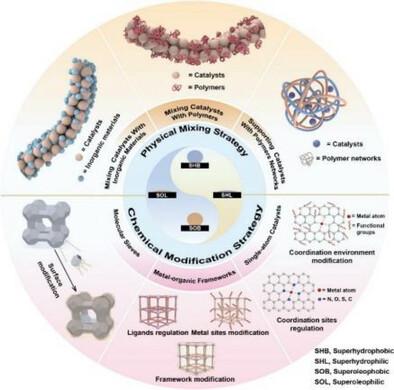当前位置:
X-MOL 学术
›
Adv. Mater.
›
论文详情
Our official English website, www.x-mol.net, welcomes your
feedback! (Note: you will need to create a separate account there.)
Superwetting Catalysts: Principle, Design, and Synthesis
Advanced Materials ( IF 27.4 ) Pub Date : 2025-06-04 , DOI: 10.1002/adma.202506058
Zaixin Zhang, Tianyi Zhao, Mingjie Liu, Lei Jiang
Advanced Materials ( IF 27.4 ) Pub Date : 2025-06-04 , DOI: 10.1002/adma.202506058
Zaixin Zhang, Tianyi Zhao, Mingjie Liu, Lei Jiang

|
Superwettability has revolutionized catalyst design for multiphase reactions by significantly enhancing interfacial interactions and mass transport. Here the design principles and synthesis strategies of superwetting catalysts are primarily introduced, with a particular focus on their confinement effects and mass transport mechanisms. First, the critical roles of superwettability is highlighted in facilitating efficient reactant mass transport, product desorption, and intermediate confinement within catalysts, which are pivotal for optimizing multiphase reaction systems. Besides, the key strategies, including physical mixing and chemical modification, are summarized to engineer superwettability interfaces in catalysts. Particular attention is given to wettability regulation in porous materials such as molecular sieves, metal–organic frameworks (MOFs), and single-atom catalysts (SACs), emphasizing its effect on improving mass transport and confinement effects. The materials used for superwetting catalysts design are summarized. Finally, future directions, including large-scale fabrication of superwetting membrane reactors, dynamic wettability tuning under operational conditions, and advanced in situ characterization techniques to capture real-time triple-phase interfacial phenomena, are outlined. These advancements are poised to expand the application of superwetting catalysts in sustainable energy, environmental remediation, and industrial catalysis, addressing key challenges in multiphase reaction systems.
中文翻译:

超润湿催化剂:原理、设计和合成
超润湿性通过显著增强界面相互作用和质量传递,彻底改变了多相反应的催化剂设计。本文主要介绍了超润湿催化剂的设计原理和合成策略,特别关注其约束效应和传质机制。首先,强调了超润湿性在促进催化剂内的有效反应物传质、产物解吸和中间限制方面的关键作用,这对于优化多相反应系统至关重要。此外,总结了包括物理混合和化学改性在内的关键策略,以设计催化剂中的超润湿性界面。特别关注分子筛、金属有机框架 (MOF) 和单原子催化剂 (SAC) 等多孔材料中的润湿性调节,强调其对改善质量传递和限制效应的影响。总结了用于超润湿催化剂设计的材料。最后,概述了未来的方向,包括超润湿膜反应器的大规模制造、作条件下的动态润湿性调整以及用于捕获实时三相界面现象的先进原位表征技术。这些进步有望扩大超润湿催化剂在可持续能源、环境修复和工业催化中的应用,解决多相反应系统中的关键挑战。
更新日期:2025-06-04
中文翻译:

超润湿催化剂:原理、设计和合成
超润湿性通过显著增强界面相互作用和质量传递,彻底改变了多相反应的催化剂设计。本文主要介绍了超润湿催化剂的设计原理和合成策略,特别关注其约束效应和传质机制。首先,强调了超润湿性在促进催化剂内的有效反应物传质、产物解吸和中间限制方面的关键作用,这对于优化多相反应系统至关重要。此外,总结了包括物理混合和化学改性在内的关键策略,以设计催化剂中的超润湿性界面。特别关注分子筛、金属有机框架 (MOF) 和单原子催化剂 (SAC) 等多孔材料中的润湿性调节,强调其对改善质量传递和限制效应的影响。总结了用于超润湿催化剂设计的材料。最后,概述了未来的方向,包括超润湿膜反应器的大规模制造、作条件下的动态润湿性调整以及用于捕获实时三相界面现象的先进原位表征技术。这些进步有望扩大超润湿催化剂在可持续能源、环境修复和工业催化中的应用,解决多相反应系统中的关键挑战。


















































 京公网安备 11010802027423号
京公网安备 11010802027423号